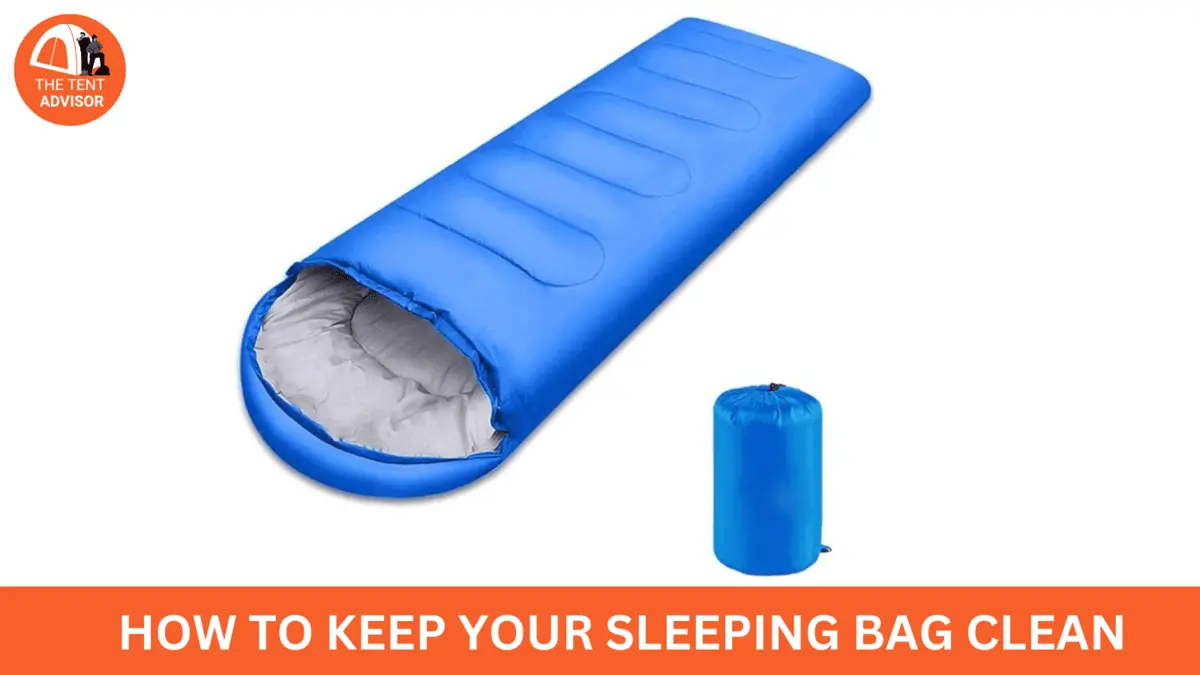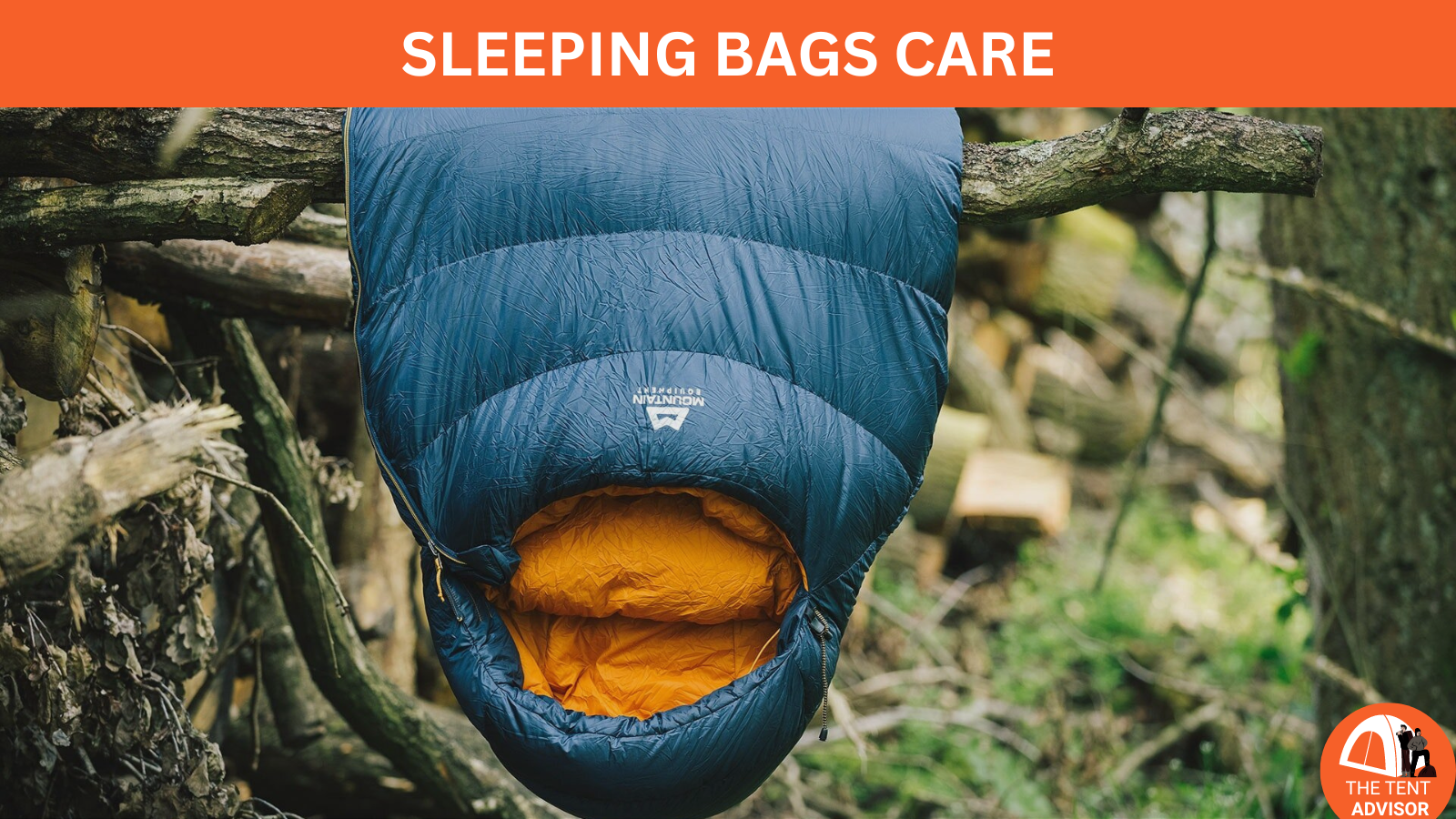Proper sleeping bags care during and after tent camping is crucial for your sleeping bag’s effectiveness, comfort, and durability. Sleeping bags are among the important gear that must be well taken care of, especially when used regularly for outdoor trips in different environments. By taking good care of the sleeping bag, you retain its thermal effectiveness and improve its shelf life.
This guide will guide you through the complete process of sleeping bag care, including when and how to wash, when dry cleaning is effective, and when to use machine washing. Additionally, there are tips on sleeping bag care, so read to the end to get the most benefits.
The Ultimate Guide to Sleeping Bag care : Tips for Longevity and Comfort

Good maintenance of your sleeping bag ensures that the insulation properties integral for warmth and comfort are preserved. With time, forgetfulness results in consequences such as down clumping or, even worse, poor-quality synthetic fill, which renders the bag unable to retain warmth.
Furthermore, improper usage and non-maintenance of sleeping bags lead to tears and damage to the regular fabrics and seams, which may interfere with the capability of a bag and its functional ability.
Benefits of Maintaining Insulation and Longevity
Before moving on, please look at the benefits of sleeping bag care to maintain its lifespan.
More Warmth:
Well-taken care of insulation within your sleeping bag means that sleeping bags will work well and be as warm as they should be.
Longer service:
Handling camouflage bags on a daily basis and irresponsible deposition of those camouflaged bags after use also encourage wear and tear, hence making the bag last longer than it otherwise would have.
Better Health:
Proper sleeping bag care prevents the accumulation of dirt, sweat, odors, and other challenging pets, making sleeping bags more comfortable and healthy.
Value for Money:
Dedicating time and effort to maintaining your sleeping bag can help you avoid early replacement or repair and save you a buck.
How to Keep Your Sleeping Bag Clean During Camping

Whether a sleeping bag is down or synthetic, it must be kept clean, dry, and protected while at a camping site. This ensures that it serves for a longer period and guarantees insulation efficiency. While these strategies are more pertinent for down bags, synthetic bags also have much to benefit from.
Sleep in Clean Clothes
After the day’s activities, after hours of exercise, there is a great temptation to hurry into the sleeping bag and sexual dew resting encircled by hunted garments. With time, every comforter will be rendered inefficient because oils, sweat, and dirt have been absorbed into the fabric.
Instead, wear clean socks and long underwear for sleep. When it is hot, sleeping underwear and a clean T-shirt are sufficient. There is also the need to wear either a knit cap or bandana to keep the oil on the hair away from the sleeping bag’s hood. Similarly, facial and neck sunscreen will get soaked into the fabric, so avoiding them before sleeping is better.
If you happen to be in bear country while camping, it is important to change out of the clothing you have been cooking in, as the food smells can attract other animals.
Consider a Sleeping Bag Liner
A liner made of cotton, silk, wool, or polyester creates a barrier between you and your bag, helping keep it clean. Liners can also add 5 to 15 degrees Fahrenheit to your bag’s warmth. After each trip, simply wash the liner, and your bag stays fresh.
Avoid placing your bag directly on the ground
When sleeping outside, apart from using a tent, deploy a soft surface such as a mat before placing your sleeping bag to avoid direct contact with the ground. A few compressed bags equipped with waterproof fabric at the bottom must also be mindful of the sharp ends of sticks and pitch.
Careful Use of Your Sleeping Bag
It’s important not to abuse your sleeping bag. Avoid standing up inside it or using your feet to prop yourself up, as this can damage the bag. Also, be mindful of others around you—if you’re sitting by a campfire, choose an older synthetic suitcase instead of a new one. Sparks from the fire can burn small holes in a down sleeping bag.
Be Selective About Lending Your Bag
If a friend decides to borrow your sleeping bag, give them all the necessary instructions, especially on how to use it. Show them how the zippers and cords should be used, and always encourage them to keep the bag using a liner.
Zippers Need Extra Care
Two-way zippers are tricky as they tend to get stuck or pull apart at the neck. Practice your bag zipper at home so that when there’s a cold tent dark and you need to pull it to the last extreme, avoid breakage. In case of zip damage you can repai it by simple methods.
For more advice read related article : How to Repair a Tent Zipper
Make Sure to Air Your Bag
Construct Daily Every once in a while, make your sleeping bag inside out to get rid of the moisture. I advise stacking it in ways without direct sunlight for too long because ultraviolet light will also degrade the fabric. When the bag gets too wet, it will probably require a few good hours in the air. When one comes home from a trip, air it out and let all the stale air out of the bag you have brought.
These procedures would enable the sleeping bag to remain in its optimal shape after having been used in poor conditions so that it accepts all the camping in such conditions uninterrupted.
Spot Cleaning Your Sleeping Bag

Most of the time, washing your sleeping bag is quite unnecessary.
Spot cleaning
It is a better approach with less aggression, which saves wear and tear and maintains the loft (the bag’s warming ability).
Add a little water to non-detergent soap for spot cleaning to form a paste. Use a toothbrush or other soft brush in a circular motion to scrub the outer shell, neck, and hood areas where most of the hair and skin oil gets trapped. Wash and rinse the shell, removing and cleaning the fabric without soaking the loft in the inside fill.
The average sleeping bag, which will last several years without a single proper wash, usually requires a spectacle.
Cleaning The Sleeping Bag
Complete this category if your bag is in a compressed state or it has turned soiled, this needs a full wash.
Begin at attempting to find the instruction to care for the item since most removable ones can have it attached to a tag or a draft tube. These are to be adhered to accurately.
Usually, campers avoid these steps and send their bags for washing. Having it cleaned professionally is an ideal way of recovering the cleaning costs of a premium-priced sleeping bag.
If you go through with cleaning the bag yourself, then be aware that drying only takes two to three hours—three to four hours in the case of down-filled bags. The simplest option is to go to the laundromat and use the big machines. Use a mild soap made specifically for down/synthetic insulation that contains no detergents. Take a book with you; it takes several minutes.
Read the article about washing a sleeping bag to understand the process better.
What Not To Do:
For any reason, do not take a sleeping bag to the dry cleaners: The inclusions of petroleum chemicals in solvents will wash away the natural oil on the down, thus cutting down its usefulness as an insulator.
Do not use bleach, oxygen bleach, or fabric softener: These can cause the materials to break down or work sub-optimally.
Do not use the top-loading machine with an agitator.
The agitator is likely to stress the seams, causing them to burst. It is fine to use the top-loading machine without an agitator, but it is preferred to use front-loading washing machines.
Following these steps will help maintain the cleanliness of your sleeping bag and allow for many more future camping excursions without the cold!
How to wash a sleeping Bag:
The Bathtub should be filled with water: Use cool or warm water and add a cleaner appropriate to your type of bag, down or synthetic. It is best not to add too much soap since too many suds complicate rinsing.
Integrate in the soap:
Place the sleeping bag in the soap water and respond to the machine, in this case, working the soap in the machine. Areas with a lot of soil pay better. Rub off the two. Allow the bag to stay in for about one hour.
Let the Bathtub drain the water first.
After soaking the bag, empty the basin and gently squeeze out most of the water.
Wash off all soap residue on the Sleeping Bag:
Change the water in the tub to fresh, cool, or even warm. Place the sleeping bag down with the soap and out of the water for a few minutes, and then drain the water again. This process should be continued until no more soap is in the water while washing the sleeping bag.
Remove All Water on the Gear:
Try to get rid of more water gently than by hand. Do not carry the bag by the carrying straps because it will stress the seam. Instead, collect the bag with those arms and roll it into a ball.
Dry the Bag:
If you have a big dryer, use it to dry the bag on low heat. If your dryer is too small, taking the bag to a laundromat is advisable. Alternatively, place the bag on a clean surface outside in the sun or in partial shade and break up the clusters of insulation as the bag dries.
How to Machine Wash a Sleeping Bag:

Choose the Right Washer:
Only do this with a front-loading washer or a top-loading machine without an agitator. Most compact, energy-efficient home washers may not be large enough for the bag to tumble freely; hence, consider using a bigger machine when necessary.
Wash on Gentle Cycle:
Put the machine on a gentle cycle with a warm or cold wash and a small amount of downwash, washing powder, or liquid soap for synthetic or down-insulated items. Using too much soap could cause the washer to over-skill.
Balance the Load:
A few, such as damp towels or T t-shirts, can be put in to help the load so that the machine’s spin is not imbalanced. Rinse Twice: Every last residue of the washing soap should be rinsed at least twice. A second wash can be done without any detergent, or a second wash-and-rinse cycle can be performed without soap.
Drying Your Sleeping Bag:
Use Low Heat: It is advisable to set the dryer on low heat and watch often. Never use high heat; it will melt the fabric or the synthetic fill.
Break Up Clumps: For the down sleeping bags, when they are almost dry, throw two or three clean tennis balls or lightweight sneakers into the dryer. This helps to break the clumps and bring back the fluff.
Although the sleeping bag is dirty, ensure it is completely dry before keeping it anywhere. As a precaution, keep it out on the bed overnight or hang it up by the toe loops.
By doing these, your sleeping bag will remain clean and will be ready for the next trip!
If you want to get information on how to wash a tent visit our guide
How to Stuff and Store a Sleeping Bag
Further, while backpacking or driving to go camping, there are times when one needs to tuck away their sleeping bag within the stuff sack. These sacks are modified into several sizes to harbor normal, compression, or waterproof options as necessary.
Advice for Using a Stuff Sack:
Please start with the Bag Foot:
To pack your sleeping bag into a stuff sack, begin by placing the foot of the bag (with the zipper partially closed) into the bottom of the sack. Push the foot in firmly and stuff the bag evenly as you move upwards. This helps push air out of the bag and applies even pressure to the stitching.
Turn Inside Out (for Waterproof Bags):
If your sleeping bag has a waterproof shell, stuff it inside out. Outer shells may contain air, which is unattractive because it turns the material into a balloon, as it does when stuffing it after removing the inner core.
Use One Size Bigger Stuff Sack:
Choose a stuff sack on the bigger side to be nose-procephalic. When you have it all in your backpack, you can further compress it.
Compression Stuff Sacks:
These sacks are better than roll bags since they have clips that can further shrink the packed sleeping bag. Space is at a premium in the pack. The sincere recommendation to never leave the bag compressed lasts weeks or even months, i.e., the extent of insulation performance is gone.
Waterproof Stuff Sacks:
If one is out hiking in wet weather, a waterproof stuff sack is needed, particularly when the bag is strapped to the back on the outside of the backpack. You can also just use a kitchen garbage bag and put it into the inner of a standard stuff sack or the whole backpack. Hiking with damp sleeping bags affects their insulative qualities, but the same cannot be said of synthetic bags, which can still insulate when wet.
Care for Your Sleeping Bag at Home:

By far, the most important thing is how and where to store the sleeping bag if one wants to use it for a long time. As a rule, after returning from a trip, do not leave the sleeping bag compressed. When dry, keep it loosely in the big cotton or mesh storage sack. These sacks come with a sleeping bag, a standard pillow case can be used, or a strongly knit cotton bag can be made.
It is important not to keep the sleeping bag awkwardly stuffed in the stuff sack for any length of time.
Over-stuffing and hoping to squash the sleeping bag inside will ruin the insulation. Instead, just avoid this situation, and remember to block every gasket hole on the bag to prevent any molding from occurring.
For your convenience, here are a few steps to help you maintain the sleeping bag and ensure it is fit for your next expedition!
Never Attempt to Jump or Sit Into the Bag
Sleeping bags are meant to provide heat and comfort and not withstand rough handling. Jumping in, standing up, or sitting in your bag can damage the seams and insulation, particularly the toe box area. Whenever possible, do not squat into the bag to avoid crumpling it.
Airing Out of the Sleeping Bag After Every Camping Trip
After every trip, let every group member try to air out their sleeping bags as a rule. You may have kept it clean, but moisture from the sweat or air condensation may have accumulated inside. This means hurrying up and drying it, which should be done by turning the bag inside out and hanging it in a well-ventilated area. This small action helps in controlling the growth of mildew and bad smell.
Be Careful When You Lend Someone Your Sleeping Bag
It is fun to use other people’s person’s gear; however, lending a sleeping bag is a sure way to have it come back in worse condition. Let them practice this before lending you your things—tell them how to wash and care for the bag liner; show them how the zippers work, how they can manhandle the material without damaging it, and that it is helpful to use a liner inside the bag to keep it in good shape.
As a Rule on Sleeping Bag Care
A sleeping bag’s burning ability, comfort, and life span depend on the user’s attitude. Aside from a particular room or area meant exclusively for this purpose, if proper care is taken when away, cleaning, drying, and storing will supplement and possibly prolong the uses of your sleeping bag and help maintain its good working condition during many more adventures. These simple steps will help you use a warmer and dryer sleeping bag regardless of your destination and cleaner.
For more information read on How to store a sleeping bag
5 Tips to Prolong the Life of Your Sleeping Bag
Sleeping bags are high-maintenance items. Use stuff only for when traveling.
It is alright to stuff a sleeping bag in a stuff sack before a journey, but do not do so over a long period.
There are times when you will need to compress the sleeping bag and use it in applications like the attic. Please do not do so with the sleeping bag; keep it in a larger loft sack, and the bag’s insulating efficiency will be preserved.
Dry Your Sleeping Bag
A sleeping bag that is wet with water has comfort issues. This is particularly crucial for down-filled sleeping bags because when wet, down gets matted and loses about 90% of its insulation efficiency. If you are camping and your bag gets damp, dry it immediately by hanging it over a tent or tree. Once back in the house, wash it properly.
Try a Sleeping Bag Liner
Using a sleeping bag liner prolongs the lifespan of the sleeping bag as it wards off sweat, dirt, and oils from staining the bag. It is made of silk and heavy, which is not desired for people on the move. If you use a liner, your sleeping bag will stay clean for a while longer, and only the liner will need washing after your trips.
Feathers must be treated with respect and caution.
If you notice feathers sticking out from the seams, don’t just pull them out. Instead, gently push them back into the stuffing by reaching inside. This will help avoid damaging the filling.
Properly clean your sleeping bag.
Even with a liner, you will eventually need to wash your sleeping bag. When it comes to washing the bag, you need to use Nikwax Down Direct. For synthetic sleeping bags, a product like Tech Wash will do the job, producing the same effect as Nikwax Down Direct.
Related articles
What is the rule no # 1 for tent camping
Best Tent Camping Checklist for Families-2024
How to choose your family tent
FAQs: Sleeping Bags care
- How should I store my sleeping bag when not in use?
Store your sleeping bag in a cool, dry place away from direct sunlight. Avoid compressing it for long periods; instead, store it uncompressed in a storage cube or sack or loosely in a box or pillowcase to maintain its loft and insulation.
- How can I tell if my sleeping bag is good for my needs?
The temperature rating of a sleeping bag determines its suitability for various conditions. Summer bags are rated 30°F and higher, 3-season bags are between 15°F to 30°F, and winter bags have a rating of 15°F and below for colder climates.
- How long will a sleeping bag last?
Depending on its material and care, a sleeping bag can last 4 to 15 years. Some bags, with proper maintenance, may even last 20-30 years.
- What age is it safe for children to start using sleeping bags?
Using a sleeping bag (sleep sack) from 12 months of age is safe when your baby can move independently. Be sure the sleep sack fits properly and is comfortable for your child to wear. You can continue using it as long as it meets these conditions.
- Can I wash my sleeping bag?
Yes, but follow the manufacturer’s instructions. In general, use a gentle cycle with a mild detergent. Avoid using a dryer or high heat; air-dry it fully to maintain the loft.
